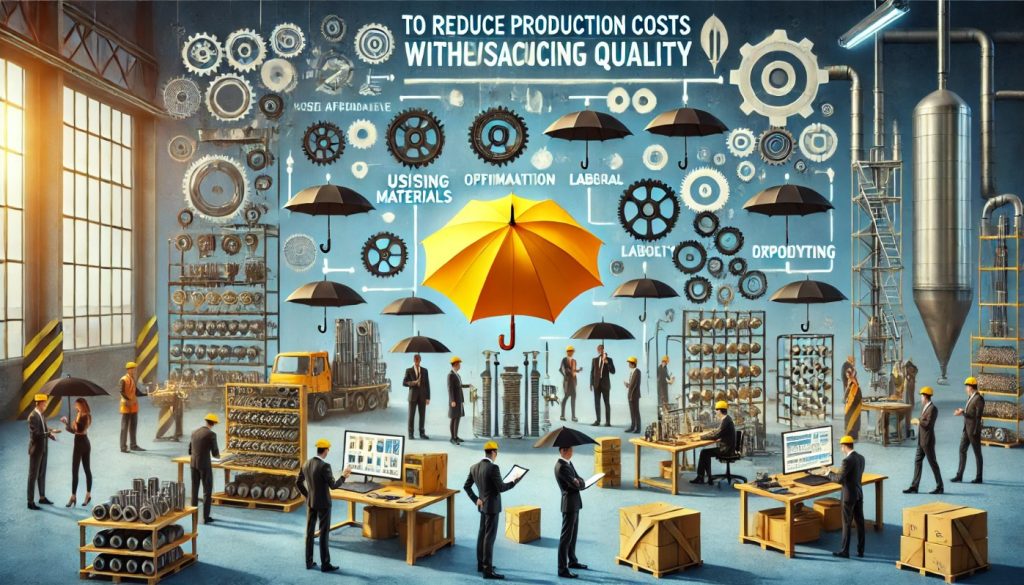In any business, controlling production costs is a vital aspect of maintaining profitability and competitiveness. However, this often comes with the challenge of ensuring that product quality does not suffer in the process. For manufacturers of umbrellas, like those involved in mass production or custom orders, balancing cost reduction with maintaining high-quality standards is especially critical.
Importance of Quality and Cost Control
For manufacturers, the challenge is not just about cutting costs—it’s about finding sustainable, efficient ways to lower costs while maintaining or even improving product quality. High-quality umbrellas are expected to withstand harsh weather conditions, provide durability, and deliver customer satisfaction, which often comes with higher production costs. But, if manufacturers can find ways to optimize their operations without compromising on the product, they can improve their profit margins and increase their market share.
The Impact of Cost Reduction on Quality
The key to effective cost reduction lies in understanding the relationship between cost and quality. Cost reduction should not mean lowering the standards of the materials, craftsmanship, or design of the umbrella. Instead, the goal is to identify areas where costs can be trimmed without affecting the final product’s performance or aesthetic appeal. By optimizing the production process, improving supply chain management, and leveraging technology, manufacturers can achieve significant savings while still delivering high-quality umbrellas.
Defining Quality in Umbrella Manufacturing
When it comes to umbrellas, quality involves a variety of elements, including:
- Material Durability: The strength and longevity of the fabric, frame, and handle.
- Performance: The umbrella’s ability to withstand strong winds, rain, and UV exposure.
- Functionality: Features such as automatic opening mechanisms, ergonomic handles, and compact folding designs.
- Aesthetic Appeal: Design, color, and overall style.
Ensuring these aspects remain high quality while reducing production costs is a multifaceted challenge that requires strategic planning and execution.
Streamlining the Supply Chain
A significant portion of production costs comes from sourcing raw materials and managing supply chains. Umbrella manufacturers rely on a range of components like fabric, steel, fiberglass, plastic, and rubber. By optimizing your supply chain, you can reduce costs while maintaining high standards of quality.
Sourcing Materials More Effectively
One of the first steps in reducing production costs is evaluating your suppliers and sourcing practices. Umbrella manufacturers need to secure materials at competitive prices, but without compromising on quality. Several strategies can help achieve this:
- Bulk Purchasing: Purchasing materials in larger quantities often reduces per-unit costs. Negotiating bulk discounts with suppliers can allow manufacturers to save on raw materials like fabric or frames.
- Supplier Diversification: Relying on a single supplier can be risky and costly. By diversifying suppliers, manufacturers can foster competition and drive down costs. It also provides flexibility if one supplier faces challenges or increases prices.
- Local Sourcing vs. Global Sourcing: Depending on your market, sourcing materials locally may reduce shipping costs and lead times, whereas global sourcing might offer lower unit prices but higher logistics expenses. Evaluate the total cost of acquisition, including shipping, tariffs, and taxes.
Establishing Long-Term Supplier Relationships
Developing long-term relationships with suppliers is a powerful way to secure better prices and ensure consistent quality. Suppliers who value long-term business relationships may be more willing to negotiate discounts, provide better payment terms, or offer priority during high-demand seasons. Strong partnerships can also lead to mutual investments in process improvements, quality control, and technology upgrades, all of which can reduce costs for both parties.
Inventory Management
Excess inventory incurs costs related to storage, handling, and potential wastage. On the other hand, insufficient inventory may result in production delays. By implementing a just-in-time (JIT) inventory system, umbrella manufacturers can balance supply and demand while minimizing storage costs. JIT involves ordering materials only when needed for production, reducing the likelihood of overstocking and wasted resources.
Optimizing the Production Process
Efficient production is central to reducing costs while maintaining quality. By streamlining workflows and implementing best practices in manufacturing, umbrella makers can improve their bottom line.
Automating Production
One of the most significant ways to reduce production costs is by implementing automation technologies. Modern manufacturing facilities can benefit from automation in several areas:
- Cutting and Sewing: Automated machines can cut fabric with precision and speed, reducing labor costs and material wastage. Similarly, sewing machines can be programmed to ensure uniform stitching, enhancing the consistency and quality of the product.
- Assembly Line Automation: Automated assembly lines can handle repetitive tasks such as attaching the frame to the canopy or installing handles, reducing the need for manual labor and speeding up production cycles.
While initial investments in automation technologies may seem high, the long-term savings can be substantial. Additionally, automation can enhance consistency, reduce human error, and increase output, all of which contribute to maintaining high quality.
Lean Manufacturing Principles
Implementing lean manufacturing principles can help identify and eliminate waste, reduce unnecessary steps in the production process, and optimize resource allocation. Key lean techniques for umbrella production include:
- Value Stream Mapping: This technique involves mapping out all the steps in the manufacturing process to identify areas of inefficiency. By focusing on value-added activities and eliminating wasteful processes, manufacturers can streamline production and reduce costs.
- Kaizen (Continuous Improvement): Kaizen emphasizes incremental improvements in processes over time. Umbrella manufacturers can create a culture of continuous improvement, encouraging employees to suggest small, cost-effective changes that can add up over time.
- Work Cell Design: Organizing the workspace into efficient cells can reduce transportation time and minimize handling, allowing workers to complete tasks in a more streamlined manner.
Reducing Waste and Scrap
Waste in the form of excess material, incorrect cuts, or defective products can lead to significant cost increases. By optimizing material usage, improving quality control, and minimizing defects, manufacturers can significantly reduce waste.
- Material Optimization: Using advanced cutting technology to maximize fabric usage and reduce scrap can help save money on raw materials. For example, utilizing computer-aided design (CAD) programs to optimize pattern layouts can ensure that fabric is used more efficiently.
- Defect Reduction: Investing in quality control measures during the production process, such as automated inspections or manual checks, can reduce the number of defective umbrellas. Fewer defective items mean less waste and lower costs related to rework and disposal.
Flexible Manufacturing
Flexibility in manufacturing allows for quick adaptation to changes in demand and market conditions. This flexibility can help prevent overproduction, which leads to excess inventory and wasted resources. By utilizing agile manufacturing techniques, umbrella manufacturers can adjust production schedules, quantities, and product types based on real-time data and customer demands.
Technology and Innovation in Umbrella Manufacturing
Technology plays a crucial role in reducing production costs while enhancing the quality of the finished product. By adopting innovative technologies, manufacturers can lower costs in various areas such as design, material selection, and quality control.
Product Design Optimization
Modern design tools, such as computer-aided design (CAD) software, enable manufacturers to optimize umbrella designs before production begins. These tools allow for precise modeling of the umbrella’s components, ensuring that each piece fits together seamlessly and efficiently. By improving design accuracy, manufacturers can reduce errors and costly reworks during the production process.
Moreover, designers can explore new materials that offer the same level of quality at a lower cost. For example, lighter or more durable fabrics may be available that meet the same performance standards as higher-cost alternatives.
3D Printing for Prototyping
3D printing technology has revolutionized prototyping and small-scale production. Rather than investing in expensive molds or tools for each new umbrella design, manufacturers can use 3D printing to rapidly prototype parts or test new features. This reduces upfront costs and enables faster iteration of product designs, helping manufacturers avoid costly mistakes.
Smart Manufacturing and Internet of Things (IoT)
IoT devices and smart manufacturing systems can provide real-time monitoring of production lines, allowing manufacturers to identify issues before they become costly problems. Sensors can detect production bottlenecks, machine malfunctions, or quality defects, enabling manufacturers to take corrective actions promptly. This real-time data not only improves operational efficiency but also helps maintain consistent quality levels, ultimately reducing waste and rework.
Labor and Workforce Management
Labor is a significant component of production costs, especially in industries that rely on manual processes. However, labor costs can be managed without compromising product quality by optimizing workforce management and investing in training programs.
Cross-Training Employees
Cross-training employees allows them to work across different areas of production, providing greater flexibility and reducing labor costs. In umbrella manufacturing, workers who are trained in multiple tasks—such as cutting, assembly, and quality control—can be moved between positions as needed to balance workloads and maintain production efficiency.
Training and Skill Development
Investing in workforce training helps reduce errors, improves productivity, and maintains product quality. Skilled workers are better at identifying defects, troubleshooting issues, and ensuring that the production process runs smoothly. As a result, fewer resources are wasted on correcting mistakes, and production cycles are shortened.
Outsourcing Non-Core Functions
In some cases, outsourcing certain aspects of production—such as packaging, logistics, or even customer service—can help reduce costs without impacting the quality of the umbrella itself. Outsourcing allows manufacturers to focus on core competencies while leveraging specialized providers for non-core tasks, which can lead to cost savings.
Scaling Production Efficiently
As demand for umbrellas fluctuates or grows, manufacturers need to scale their production processes effectively. Scaling efficiently can reduce unit costs and improve profit margins without sacrificing quality.
Economies of Scale
Economies of scale refer to the cost advantages gained by producing goods in larger quantities. By increasing production volume, manufacturers can spread fixed costs (such as factory overhead and equipment) over a larger number of units, reducing the per-unit cost. Scaling production also allows manufacturers to negotiate better deals with suppliers, further reducing material costs.
Flexible Production Schedules
When demand spikes, umbrella manufacturers need to scale production quickly. Having a flexible production schedule that accommodates increased order volumes can help manufacturers avoid bottlenecks and delays, ensuring that quality remains consistent even when production rates increase.
By implementing these strategies, umbrella manufacturers can significantly reduce production costs while maintaining high-quality standards. Effective supply chain management, process optimization, technological innovation, and workforce efficiency all play critical roles in this delicate balance. Ultimately, the goal is to create umbrellas that meet customer expectations, are durable and functional, and are competitively priced—all while safeguarding profitability for the business.






